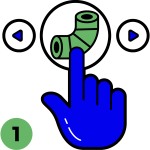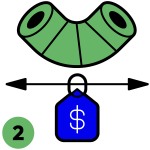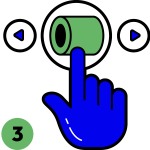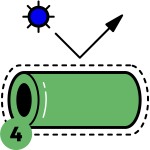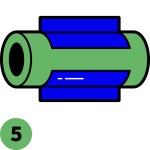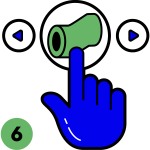
|
|
| ||||||||||||||||||||||||||||||
| "If there be any among us who [disagree], let them stand undisturbed as monuments of the safety with which error of opinion may be tolerated, where reason is left free to combat it." Thomas Jefferson, March 4, 1801 |
Clear PVC Pipe & Acrylic Tube |
Sch 40 White PVC Plumbing Pipe |
Sch 80 Gray PVC Plumbing Pipe |
Furniture Grade Glossy White Pipe |
PVC CTS CPVC Pipe |
Thinwall PVC Pipe |
Metric PVC Pipe |
|
|
Flexible & Rigid PVC Pipe Size Table with Dimensions & Pressure Ratings Chart for identification and use classification. |
PVC Pipe is identified by the ID (Inside Diameter) and is referred to as a "nominal" size which means "in name only." However this confuses people and most novices try to use the OD (Outer Diameter) to order parts. If you do this, measure the OD of your pipe and find it the 2nd column of the chart below. Now look to the left (1st column) and that's the size of pipe and fittings you buy.
If this is a pressure rated system, move to the right to find the maximum working pressure your system will see and go up to the top of the column to see the schedule or class pipe you should have. If you are using Flexible PVC pipe, look for the blue box inset in the yellow box for pressure ratings. (The size is the same, only the pressure rating changes for FlexPVC.) If you are looking for flow rates, see PVC Pipe Flow Chart.) For WEIGHT PER FOOT please see PVC & CPVC PIPE SPECS Weight Per foot and dimensions..
To purchase short pieces of RIGID PVC pipe click here or Click here to buy short sections of FLEXIBLE pvc pipe.
| Rigid & Flexible PVC Pipe Size Chart with ID/OD Dimensions & Pressure Ratings, including Clear PVC Pipe | ||||||||||||
| Buy this size, ie, "nominal" | Pipe Outside Diameter, OD Tolerance +/- .01"/.25mm (Inches, millimeters) |
Click Here To Buy Schedule 40 pipe. | Click Here To Buy Schedule 80 pipe. | Click Here To Buy Class 200 pipe. | ||||||||
| ID* Inches |
Wall Thickness* Inches |
Rigid Pipe P.S.I.** |
CLEAR Rigid Pipe P.S.I.** |
Flexible PVC Pipe Working/Burst P.S.I.**@68F (MORE DETAILED DATA) |
ID* Inches |
Wall Thickness* Inches |
P.S.I.** | ID* Inches |
Wall Thickness* Inches |
P.S.I.** | ||
| 1/8" | .405 (~13/32", 10.31mm) | .249 | .068 | 810 | -- | --/-- | .195 | .095 | 1230 | -- | -- | -- |
| 1/4" | .540 (~1/2", 13.75mm) | .344 | .088 | 780 | 390 | --/-- | .282 | .119 | 1130 | -- | -- | -- |
| 3/8" | .675 (~5/8", 17.14mm) | .473 | .091 | 620 | 310 | --/-- | .403 | .126 | 920 | -- | -- | -- |
| 1/2" | .840 (~7/8", 21.336mm) | .622 | .109 | 600 | 300 | 100/400 [BUY] | .546 | .147 | 850 | 0.716 | 0.062 | 200 |
| 3/4" | 1.050 (~1", 26.670mm) | .824 | .113 | 480 | 240 | 100/400 [BUY] | .742 | .154 | 690 | 0.930 | 0.060 | 200 |
| 1" | 1.315 (~1-5/16", 33.401mm) | 1.049 | .133 | 450 | 220 | 100/355[BUY] | .957 | .179 | 630 | 1.189 | 0.063 | 200 |
| 1-1/4" | 1.660 (~1-5/8", 42.164mm) | 1.380 | .140 | 370 | 180 | 80/250[BUY] | 1.278 | .191 | 520 | 1.502 | 0.079 | 200 |
| 1-1/2" | 1.900 (~1-7/8", 48.260mm) | 1.610 | .145 | 330 | 170 | 65/200[BUY] | 1.500 | .200 | 470 | 1.720 | 0.090 | 200 |
| 2" | 2.375 (~2-3/8", 60.325mm) | 2.067 | .154 | 280 | 140 | 60/175[BUY] | 1.939 | .218 | 400 | 2.149 | 0.113 | 200 |
| 2-1/2" | 2.875 (~2-7/8", 73.025mm) | 2.469 | .203 | 300 | 150 | 50/125[BUY] | 2.323 | .276 | 420 | 2.601 | 0.137 | 200 |
| 3" | 3.500 (3-1/2", 88.900mm) | 3.068 | .216 | 260 | 130 | 50/125[BUY] | 2.900 | .300 | 370 | 3.166 | 0.167 | 200 |
| 4" | 4.500 (4-1/2", 114.300mm) | 4.026 | .237 | 220 | 110 | 45/100[BUY] | 3.826 | .337 | 320 | 4.072 | 0.214 | 200 |
| 5" | 5.563 (~5-1/2", 141.300mm) | 5.047 | .258 | 190 | -- | --/-- | 4.768 | .375 | 290 | -- | -- | -- |
| 6" | 6.625 (~6-5/8", 168.275mm) | 6.065 | .280 | 180 | 90 | 45/100[BUY] | 5.761 | .432 | 280 | Click Here For Thinwall 6" | ||
| 8" | 8.625 (~8-5/8", 219.075mm) | 7.961 | .332 | 160 | 80 | -- | 7.565 | .500 | 250 | Click Here For Thinwall 8" | ||
| 10" | 10.750 (10-3/4", 273.050mm) | 9.976 | .365 | 140 | 70 | -- | 9.492 | .593 | 230 | Click Here For PVC Duct Pipe | ||
| 12" | 12.750 (12-3/4", 323.850mm) | 11.890 | .406 | 130 | 70 | -- | 11.294 | .687 | 230 | Click Here For PVC Duct Pipe | ||
| Note: On sizes 14" and larger the Outside Diameter becomes the Nominal Size as opposed to the smaller sizes were the Inside Diameter is the Nominal Diameter. | ||||||||||||
| 14"(click to buy) | 14.000 | 13.073 | .447 | 130 | -- | -- | 12.410 | .750 | 220 | Click Here For PVC Duct Pipe | ||
| 16" | 16.000 | 14.940 | .500 | 130 | -- | -- | 14.213 | .843 | 220 | Click Here For PVC Duct Pipe | ||
| 18" | 18.000 | 16.809 | .562 | 130 | -- | -- | 16.014 | .937 | 220 | Click Here For PVC Duct Pipe | ||
| 20" | 20.000 | 18.743 | .5937 | 130 | -- | -- | 17.814 | 1.031 | 220 | Click Here For PVC Duct Pipe | ||
| 24" | 24.000 | 22.554 | .687 | 120 | -- | -- | 21.418 | 1.218 | 210 | Click Here For PVC Duct Pipe | ||
| *ID and wall thickness can vary from .2% up to 5% (Some pipe can vary more than that, if the wall thickness or ID is critical, please contact us with your needs.) Only the pipe OD is held to tolerance. Pipe ID will vary, even along a single piece of pipe. |
||||||||||||
CPVC CTS Pipe Sizes. This is a fairly rare pipe and used mostly for hot water systems.
The pipe is almond colored (yellowish) and does not work with Sch 40/80 fittings, although we do have some CTS fittings, including Sch 40/80 to CTS adapters and
CPVC CTS Pipe.
| Size Nominal (inches) |
Outside Diameter (inches) |
Inside Diameter (inches) |
Weight (lbs/ft) |
|---|---|---|---|
| ½ | 0.625 | 0.485 | 0.085 |
| ¾ | 0.875 | 0.713 | 0.140 |
| 1 | 1.125 | 0.921 | 0.218 |
| 1¼ | 1.375 | 1.125 | 0.330 |
| 1½ | 1.625 | 1.329 | 0.460 |
| 2 | 2.125 | 1.739 | 0.790 |
DIN Metric Pipe Sizes
| Nominal Size | OD (mm/inches)* | ID (mm/inches) | Wall Thickness (mm) |
| 32mm DIN | 32mm/1.25" | 27mm/1.06 | 2.4mm |
| 40mm DIN | 40mm/1.57" | 33mm/1.31 | 3.0mm |
| 50mm DIN | 50mm/1.96" | 42mm/1.64 | 3.7mm |
| 63mm DIN | 63mm/2.48" | 53mm/2.09 | 4.7mm |
*Metric Pipe OD is +/- .2mm. Pipe ID and wall thickness can vary from .2% up to 5%. Pipe ID will vary, even along a single piece of pipe.
Metric Pipe is here and Metric Fittings Here
**Disclaimer: Pressure ratings above are for a temperature of 68-73F. See de-rating chart below for higher temperatures.
Temperature/Pressure Derating Chart
| Operating Temperature F°(C°) | 73(23) | 80(27) | 90(32) | 100(38) | 110(43) | 120(49) | 130(54) | 140(60) |
| PVC Pipe | 100% | 90% | 75% | 62% | 50% | 40% | 30% | 22% |
| Note: The temperature ratings above are for the temp of the pipe, not the fluid traveling through it. Typically the temperature of the pipe is much less than the fluid going through it due to radiation (heat loss) and the heat barrier effect, ie the insulating properties of the pipe. | ||||||||
(Chart and HTML copyright FlexPVC®.com 2004-2025)
To convert from psi to feet of head, see our Feet of Head Pressure to PSI Chart. (PDF, opens in a new window so you can print it.)
Other, less common, Large PVC Pipe Outside Diameters (PDF, opens in a new window)
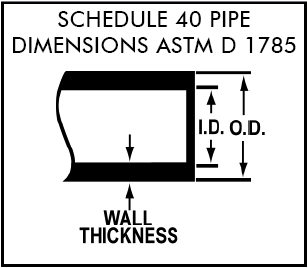 Further Reading:
|
PVC PIPE 12" and smaller is identified and sold based on the Inside Diameter (ID). Sizes 14" and larger are identified and sold based on the Outside Diameter (OD.) In the chart above you will see the OD stays the same, only the wall thickness changes. Fittings are identified and sold based on the nominal size (first column) of the pipe and classification of the fittings and pipe. Ie if you have Sch 40 1" pipe, you buy Sch 40 1" fittings. For any system that is pressurized you should use the same classification of pipe and fittings. But for constructed (structural) projects you can generally mix and match different classifications. If this is a new pressurized project, use the pressure ratings guide above to select what classification/schedule you will need for your project. If you are working with a system already plumbed, you may be able to read the printing on the pipe. If you can't find the printing, you will have to cut the pipe to measure the wall thickness to know for sure what pipe you have. If you are building a structural project and using fittings to construct something that will never see flow through the pipe, you pick the size of pipe based on the physical strength you need. Sch 80 is the thickest wall, and therefore strongest pipe. However, the fittings used for construction projects do not come in Sch 80, only sch 40. If you are trying to make something light and it won't be used for anything heavy, class 200 pipe will save weight and money. If you are using it to hold up heavy objects or span long distances, sch 80 pipe is the strongest readily available pipe. Sch 40 pipe is typically used for these projects because it has the best strength/weight/cost ratio and is widely available. If you have special needs you can consider using other pipe schedules and/or classifications of the same size because they will all have the same OD of the pipe. Using Class 200 pipe saves weight and money but has lower strength. Using PVC pipe to build constructed items like racks, shelving systems, canopies, etc, is outside the design limits of the product. PVC Distributors will not be held liable for any failures or injuries caused by a failure of the pipe or fittings in such situations. You can also use this chart as a general guideline to find telescoping pipe possibilities. Find a pipe with an OD just slightly smaller than the ID of another pipe. That will be your best bet to find pipe that will telescope inside of each other. Remember, pipe ID can vary, so sometimes trial and error is the only way to produce a satisfactory result. Also see Sch 40 (white) and Sch 80 (dark gray) PVC Pipe Specs. Click on the logo on the top left of the page to return home. |
|
Home Contact SIGN UP FOR OUR EMAIL LIST - for free gifts every month, discount codes and product announcements. |
FAQ Application Guidelines Technical Articles Technical References Technical Videos Prop 65 Warning |
Privacy Statement Terms & Conditions Warranty Disclaimer Shortcuts Shopping Cart Sitemap |
Our Charities & other important issues. Plumbing & Irrigation Directory Location:216.73.216.125 Links Blog KeyCDN and Bunny.NET work well. |
| All text, images, layout and design Copyright 2002 - 2025 FlexPVC ®, PVC Distributors LLC. - - - FlexPVC ® is a Registered Trademark of PVC Distributors LLC | |||



